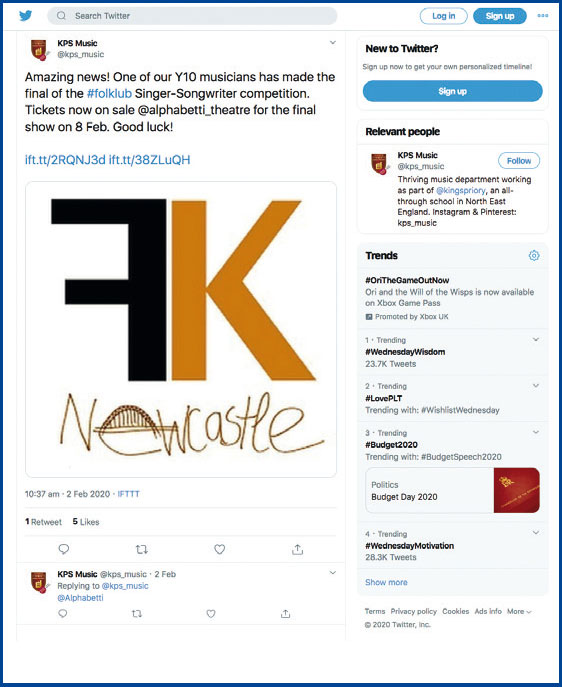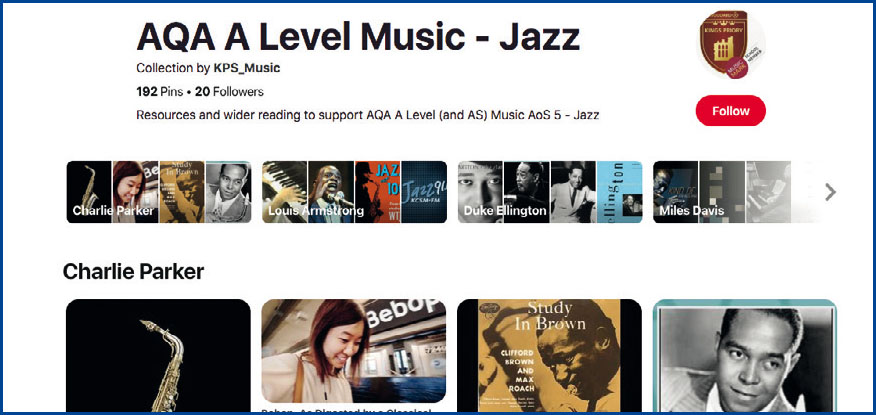
Over the last four years I have been trying to make greater use of social media within our department. In this time I've found that, while there is a fair amount of work involved, social media can be a highly effective tool for engaging pupils and parents in school events and celebrating pupil successes. Alongside the PE department, the average music department will likely have significantly more ‘content’ suitable for social media than any other in the school, so even the least active accounts are likely to garner a fair degree of interest within the school community.
This article details the lessons I've learnt from running our school's social media content, but it is by no means meant as a how-to guide. Each school is different and not all the platforms and approaches detailed will be appropriate for every setting. There may also be some school music departments that feel they can take social media much further than I have. If you are new to social media in a professional context, or wish to try out a new platform or technique, I would strongly recommend running any ideas past your school's e-safety officer. Many schools have understandably strict regulations concerning the use of social media, particularly when this involves personal devices, so it's better to be informed of your school's position early on.
‘Microblogging’ is a slightly outdated term today, but it describes a sizeable chunk of our department's social media output. I've found that parents really value a semi-regular update on events that have occurred in the music department, along with details of upcoming activities. I've found that Twitter is the best choice for this purpose, given its ubiquity and the short snappy nature of a tweet. I've found that a great deal of parents use the platform and are more than willing to follow school accounts to garner information.

(1) A post celebrating a pupil's success in a recent local songwriting competition.
If you're new to Twitter, its sheer scale can be rather daunting. While I'll focus more on the use of the platform for departments rather than individuals, I'd recommend creating your own ‘professional’ Twitter account to allow you to get a feel for the landscape away from an account that carries school branding. I was already a fairly avid Twitter user prior to starting our school account, and have found it useful to have a separate teacher account alongside my ‘private’ account, allowing me to engage with other professionals without fear of anyone discovering tweets made in my younger years.
If you're starting a new account (or revamping an existing one) there is no need to extensively follow other accounts, though I've found it can be useful to follow other music departments to see how others use the platform. It can also be beneficial to follow local music providers such as the local music hub, any community bands, local venues and so on, to keep an eye out for events that may interest pupils and their parents. Do bear in mind that while it can be useful to have an overview of local events, a ‘follow’ can be seen as an endorsement, so it is worth being careful about which accounts you link to a school branded account.
Twitter was the first platform I adopted when building our department's social media presence and, while I found it to be very useful in getting information to parents, it seemed to make relatively little impact on pupils. I was keen to find a way to engage our older pupils with events in school and to get information out quickly. Many pupils said that while they had Twitter accounts, most of their social media time was spent on Instagram. This was a few years ago and, while other platforms have come and gone in that time, Instagram appears to be very popular still.
For anyone unaware, Instagram is based more around images, though you also have the option to add a text caption. Initially I used Twitter and Instagram separately but found this to be fairly ineffective and time consuming. It is possible via the Instagram app to link your account to a Twitter account and have any ‘grams’ posted as tweets, showing the caption and a URL that takes the user to Instagram to view the image. This seemed overly clunky, so I looked around and discovered an app called IFTTT (which stands for ‘If That Then This’). This powerful app allows you to automate many things, but I specifically use it to turn Instagram posts automatically into Tweets that include the image, something I've found invaluable.
As well as publicity for the department, I've found social media to be a great tool for sharing online resources and web links with pupils. As an avid follower of the Australian teacher Katie Wardrobe's Midnight Music platform, I was particularly impressed by her extensive use of Pinterest to share links on a wide range of subjects. Pinterest allows you to create categorised ‘boards’ to which you can attach ‘pins’ – usually images, but also web links.
Over the past couple of years I've created boards for each of our GCSE and A level modules, which I've populated with articles and YouTube links to encourage wider reading and listening. I've also found it useful to develop boards for topics in younger year groups too. At the end of our ‘instruments of the orchestra’ module, our Year 7s undertake independent study of an orchestral instrument of their choice. Rather than simply letting pupils loose on Wikipedia, I've compiled a short selection of good sites on Pinterest that I can point pupils towards as a starting point.
Other platforms
There are a great number of ‘online classroom’ services available that, aside from communication with parents, allow you to do much of what's already been mentioned. Our department uses Google Classroom, as I've found it to have the best Google Suite integration (each of our pupils has a school Google Suite account, and much of our work is done via Google products). While this doesn't fall specifically under the remit of social media, it may be worth considering whether you can achieve your goals through such a platform, as the closed nature of an online classroom is often a safer environment for teacher-pupil contact.

An A level music Pinterest board
While I'm aware of many teachers who use Facebook within their departments, I've yet to find a use of it that isn't better served by one of the platforms already mentioned. It is probably more useful for connecting with parents than with pupils.
TikTok, the newest widespread platform being used by young people, is arguably the best place to engage with pupils at the moment. I have yet to see effective use for it within a music education context, though this is definitely an area I'd like to develop.
General rules
As mentioned, I'd strongly recommend speaking to the member of staff responsible for e-safety in your school before embarking on any new use of social media. Each school will likely have specific recommendations for online conduct.
You may notice in one of the earlier pictured examples that I refer to ‘one of our Y10 musicians’ rather than using the pupil's name. I have seen many examples of school accounts referring to pupils by name (though usually only a large Twitter presence, with most departments and year groups having their own accounts, and many use pupils' first names in tweets. However, I feel more comfortable giving pupils a degree of anonymity (even if some decide not to use it – I've had several instances of pupils replying to similar posts with comments along the line of ‘That's me!’).
I also try to avoid any pictures of pupils if possible, or at the very least avoid including pupils' faces. As with pupils' names, there are many schools that post easily recognisable images of pupils, and this may not present any issues at your school. However, I feel more comfortable giving pupils choice over where their image appears online.
While engagement is a key goal of any social media use, I generally avoid active engagement with individuals (either pupils or parents) on any social media platform. I will actively encourage pupils and parents to comment and share posts we've made, but I keep these conversations strictly to school email.
The best advice I can give to anyone wishing to develop a social media presence for their department is to look into practice at other schools by delving into your chosen platform(s). There are some fantastic examples of schools filling the internet with the achievements of their pupils and, in my experience, young people really appreciate by first name) and, if this is permitted within your school regulations, it shouldn't cause any issues. Our school has seeing their achievements within the school environment reflected online.








